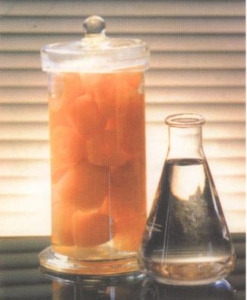Phosphorus Chemical Industry
There are three allotropes of phosphorus, yellow phosphorus, red phosphorus, and black phosphorus. Yellow phosphorus (also known as white phosphorus) is the most important, it is the basic raw material for preparing red phosphorus and phosphorus compounds. Therefore, large-scale production of cheap yellow phosphorus is an important condition for the production of a series of phosphorus compounds.
According to literature records, yellow phosphorus was first produced in 1830 by small-scale production of ashes, sulfuric acid and charcoal. Later, industrialization attempts were made with the smelting furnace method, but the production technology was not ideal.
It was not until 1888 that Britain first tried electric furnaces to produce yellow phosphorus, turning a new page in the history of yellow phosphorus production. In 1890, Britain established a single-phase suspended vertical electrode electric furnace to produce yellow phosphorus. The world’s first industrial phosphorus electric furnace started operation in France in 1891.
 In 1914, the Southern Electric Company built the yellow phosphorus electric furnace with the largest capacity in the world. In order to meet the needs of thermal phosphoric acid and water treatment, phosphate for detergents, and war, in order to further reduce the cost of yellow phosphorus, countries started to build large-capacity electric furnaces after 1940.
In 1914, the Southern Electric Company built the yellow phosphorus electric furnace with the largest capacity in the world. In order to meet the needs of thermal phosphoric acid and water treatment, phosphate for detergents, and war, in order to further reduce the cost of yellow phosphorus, countries started to build large-capacity electric furnaces after 1940.
Due to the reduction of the cost of yellow phosphorus, good conditions have been created for the production of phosphide and phosphate.
During this period, in addition to the research of electric furnace method of yellow phosphorus, the blast furnace method of yellow phosphorus was also studied, but it was not widely promoted due to product purity and cost.
Thermal phosphoric acid was first produced in England in 1890. Thermal phosphoric acid is an important intermediate raw material for the production of phosphate. After the First World War, due to the large-scale production of yellow phosphorous and the application of phosphate in water treatment, thermal phosphoric acid has been greatly developed.
Phosphorus-containing detergent In 1927, Germany used electrothermal phosphoric acid to industrially produce sodium phosphate. Since 1948, the detergent, feed, and fertilizer industries have rapidly increased their demand for phosphates and have been greatly developed.
Wet-process phosphoric acid is a much larger product than thermal phosphoric acid. About 10% of it is used to make phosphate fertilizers. Wet-process phosphoric acid began production in 1850 and is used as an intermediate in the production of phosphate fertilizers and used to make fertilizers. Between 1870-1872, Germany achieved industrial production.
